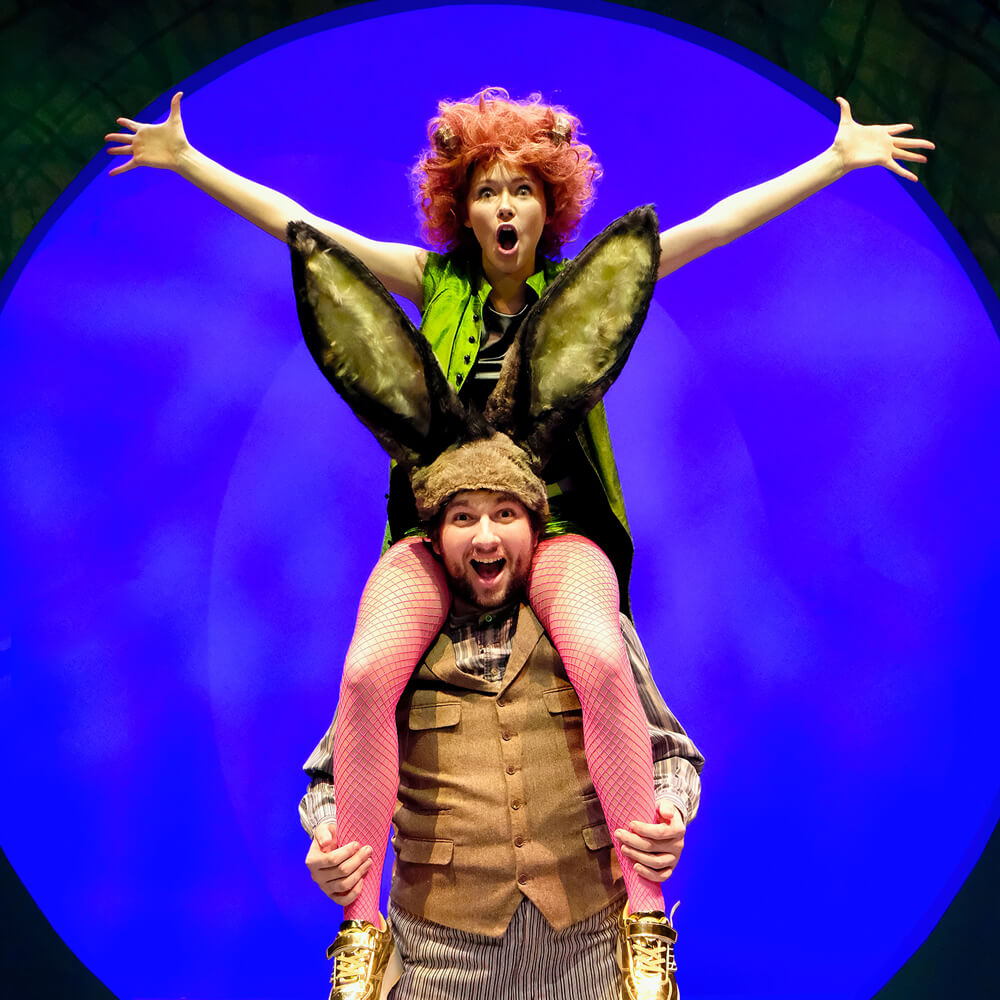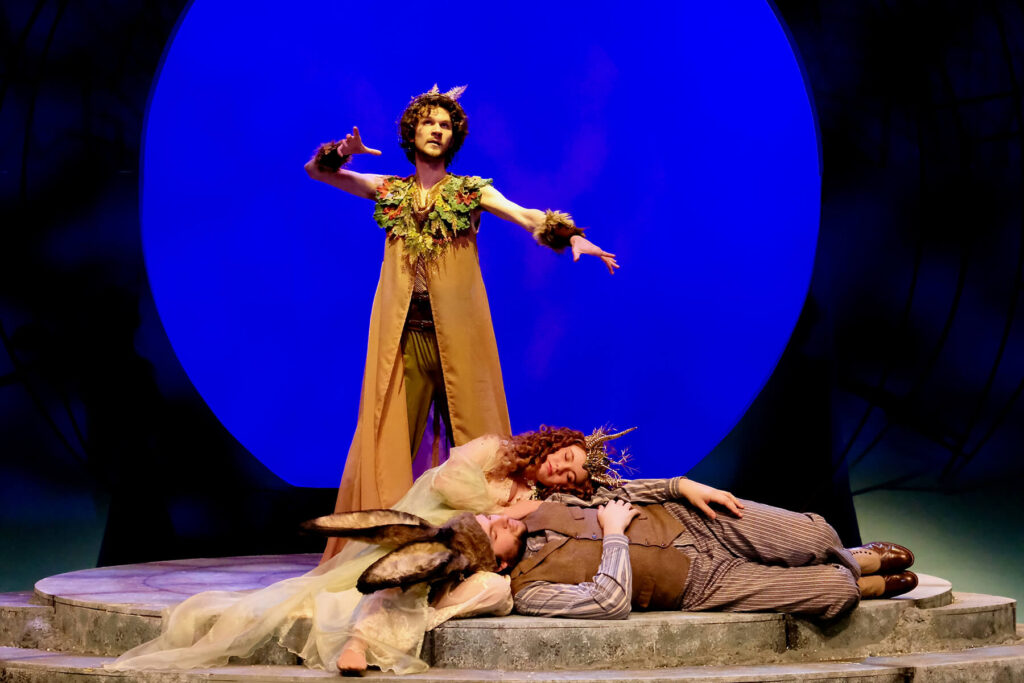Student Composer Sets the Mood for Theatre & Dance Production of “A Midsummer Night’s Dream”
Posted Feb 13, 2024
Deep in a magical forest, mortals and fairies collide, resulting in tempestuous love triangles, contagious fogs and moonlight revels — proving that “the course of true love never did run smooth.” Shakespeare’s best-known comedy, “A Midsummer Night’s Dream,” is a fairy tale about the complexities of human relationships and the often-hilarious path to love.
And the path to love in Otterbein’s production is set to music written by senior David Zimmerman, a senior music composition and economics double major from Grandview, Ohio.
When Director Mark Mineart reached out to Music Professor Jennifer Merkowitz about the possibility of having a student write for a show, she immediately thought of Zimmerman. “He is a singer and has written for voices before — in fact, he will also have a brand-new choral piece premiered by Concert Choir at the Winter Choral Concert on Feb. 18. He has also been involved in Opera Theatre, so he has experience with the combination of music and drama,” she said.
“After our first meeting with Mark, David immediately sat down at the piano and started working on the fairies’ lullaby. Since finishing the agreed-upon songs, he’s also made some other arrangements and audio files for different places in the show. I’m really excited to see how it all works in the production,” Merkowitz added.
Zimmerman was honored to have the chance to write for the production. “Otterbein’s Department of Theatre and Dance is one of the most esteemed and skilled college theater programs in the nation. The productions they put on are known to be legendary, so when I found out that I was requested to write the music for the play, I was ecstatic, but determined. I know the level of quality that this department is used to/expected to produce, so I knew I had to bring my best,” he said.
The two main anthems composed by Zimmerman are Queen’s Lullaby and Break of Day, with a smaller third piece created called Chase.
Queen’s Lullaby was a unique composition in every way. “Dr. Merkowitz and I were having our first meeting with the director, Mark Mineart. This was a very conceptual meeting, discussing what we thought the music should sound like. After listening to some reference videos and discussing further, a lightbulb awakened in me. The second the door closed on Mark’s exit, I swiveled around to the piano and crafted the Queen’s Lullaby almost in its entirety! How about that?” Zimmerman recounted.
“The lullaby focuses on the fairies of the show, singing the queen to sleep. It is an elegant lullaby ballad with cooler, dense harmony structured around a dark, minor tonality. Added with a rich string section and ethereal vocal lines, a flavor of mystical mystery is captured for the audience to enjoy. It plays into the characteristics of the fairies as they sing of magic/spells and the creatures of the forest. The song is quite additive, as with every passing phrase, more ingredients are added, diving ever deeper into the piece’s character, its soul. With a delicate ending, it’s truly a treat to listen to!”
For Queen’s Lullaby, Zimmerman said he was inspired by “old folk music, music you’d hear in a dim lit tavern back in the 1600s, Shakespeare’s hey-day! I asked myself, ‘What would the pirates, fairies, and common folk of the day hear?’”
Zimmerman said the other compositions took more time. “My process followed the same suit of listening to reference recordings for inspiration, discussing creative wants with the director, bouncing those through Dr. Merkowitz, and then finally taking a leap of faith into music writing,” he said. “I always lay down a chord progression/bassline first to get the atmosphere of the piece, then make necessary adjustments of that atmosphere off the melody, which is created next. On occasion, the melodic line of a work comes into my head first, and then the chord progression simply writes itself. From there, the harmonies, instrumental work, and dynamics are made. I touch up a few spots, and the piece is done!”
Zimmerman said Break of Day took a few weeks to complete, and Chase took a few days.
“Break of Day was definitely the most unique out of the bunch in line with it being the hardest to write,” he said. “Break of Day is the production’s final flourish, celebrating the wedding of Theseus (the Duke of Athens) and Hippolyta (Queen of the Amazons). It is a feel-good heroic showstopper celebrating love and new life, as felt through its upbeat tempo, uplifting vocals, and resounding string orchestra. Its dynamic build drives the piece all the way to the final monologue, where the piece is reprised into a bittersweet ending set of chords. This signifies the end of the show, but also passes the responsibility to the audience to go out and spread love in their own lives.”
Zimmerman also composed a small instrumental tune called Chase, which accompanies the change and reaction of Nick Bottom being turned into a donkey. “It is a simple, circus-style, tongue-in-cheek anthem that enhances the scene in its own right,” he said.
Seeing his compositions performed on stage was transformative for the composer. “It is a truly special and fortunate feeling that Mark Mineart, the production team, and the Department of Theatre and Dance have kindly given me. The feeling of joy, gratitude, and pride hearing the cast singing my work is amazing and has made a memory I’ll look back on with a big smile,” he said.


More than that, Merkowitz said collaborations like this teach skills that students carry with them into their careers. “I think being able to work with other artists to achieve a shared goal is so important. In addition to the challenge of writing and creating the audio tracks for the music that was needed for the various scenes in the show, there were a lot of other real-world stakes baked into the process: meeting deadlines, communicating with the director, teaching the music to the actors, and coordinating with the sound designer.”
“There is nothing like this kind of project to instill the importance of time management and working relationships, not to mention the immense pride that one feels being part of a team that is working together to create a special experience for an audience,” Merkowitz said. “Collaborations like these are great experiential learning opportunities that prepare our students for their professional lives.”
You can catch the closing weekend of the Otterbein University Department of Theatre and Dance’s production of “A Midsummer Night’s Dream,” Feb. 15-18 with shows at 8 p.m. in the Fritsche Theatre at Cowan Hall 30 S. Grove St., Westerville. Tickets cost $22. Call 614-823-1109 or visit https://www.otterbein.edu/drama/.
The box office is open 12-4 p.m., Tuesday through Friday, and one hour prior to performances. It is located in Cowan Hall, 30 S. Grove St. Student Rush discounts are available one hour prior to curtain, pending ticket availability.
PRODUCTION TEAM
Directed by Mark Mineart
Scenic Design by Isaac Ramsey
Costume Design by Rebecca White
Lighting Design by Kyle Krygielski
Sound Design by Nicole Hunter
Stage Managed by Libby Carroll
CAST LIST
Oberon / Theseus: Ben Sanford
Titania / Hippolyta: Nora Shearer
Puck / Philostrate: Kateri Condon
Egeia: Sierra Gelbman
Hermia: Claire Stancy
Helena: Emma Bailey
Demetrius: David Graves
Lysander: Roberto Silva-Neto
Peter Quince: Jack Giglia
Nick Bottom: Nathan Frewen
Francis Flute: Ian Peloza
Snug: Sam Bryant
Robin Starveling: Aidan McCracken
Tom Snout: Calvin Freshour
Faerie Ensemble: Evan Blust, Kate Maree Brewer, Sherlyn Diaz, Naomi Eason, Kateje Palmer, Sammi Robinson, Quinn Seevers